Financial Management Assessment for BSB61015 - Term 2, 2017
VerifiedAdded on 2021/04/17
|22
|4778
|21
Homework Assignment
AI Summary
This document contains the solutions to a Financial Management assessment for the BSB61015 Advanced Diploma in Leadership and Management. The assessment is divided into three weeks, covering various topics in financial management. Week 2 focuses on short answer responses, exploring topics such as profitable businesses, reasons for business failures, fundamental accounting concepts (Business Entity, Dual Aspect, Money Measurement, Objectivity, Going Concern, Periodicity, Cost, Conservatism, Materiality, Realisation, Matching, and Full Disclosure), investment, financing, and financial management decisions, and financial ratios. Week 3 involves research on the Australian Tax Office (ATO), bilateral and regional trade agreements, the Trade Practices Act, key Australian taxation requirements (PAYG, company tax, GST, financial probity, ABN, BAS, superannuation, FBT, and income tax), International Commercial Terms (INCOTERMS), the role of the World Trade Organization (WTO), and the calculation of GST. Week 4 requires the preparation of a Profit & Loss Statement and a Balance Sheet using provided financial information. The document provides detailed answers and explanations for each question, offering a comprehensive solution to the assessment.
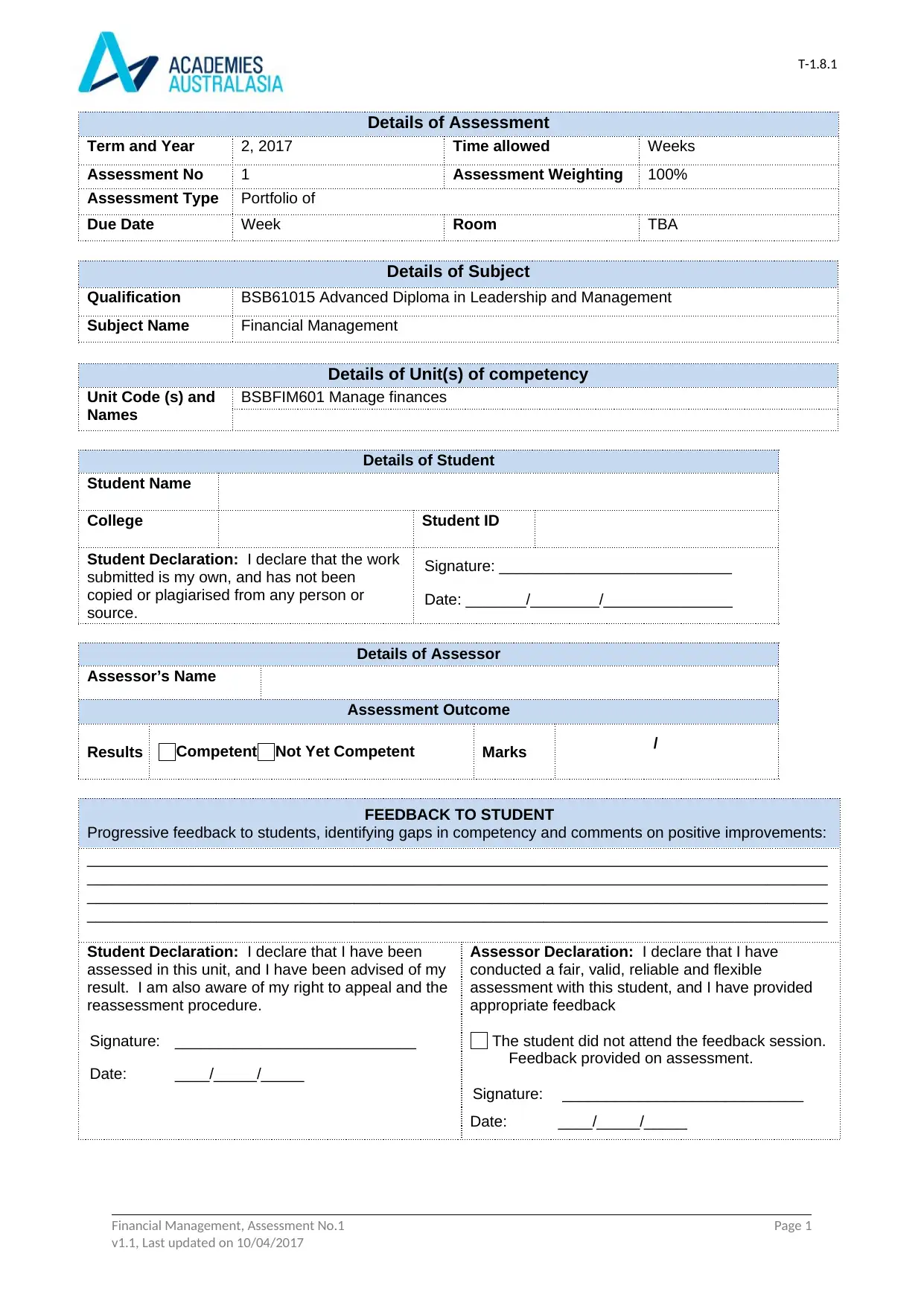
T-1.8.1
Details of Assessment
Term and Year 2, 2017 Time allowed Weeks
Assessment No 1 Assessment Weighting 100%
Assessment Type Portfolio of
Due Date Week Room TBA
Details of Subject
Qualification BSB61015 Advanced Diploma in Leadership and Management
Subject Name Financial Management
Details of Unit(s) of competency
Unit Code (s) and
Names
BSBFIM601 Manage finances
Details of Student
Student Name
College Student ID
Student Declaration: I declare that the work
submitted is my own, and has not been
copied or plagiarised from any person or
source.
Signature: ___________________________
Date: _______/________/_______________
Details of Assessor
Assessor’s Name
Assessment Outcome
Results Competent Not Yet Competent Marks /
FEEDBACK TO STUDENT
Progressive feedback to students, identifying gaps in competency and comments on positive improvements:
______________________________________________________________________________________
______________________________________________________________________________________
______________________________________________________________________________________
______________________________________________________________________________________
Student Declaration: I declare that I have been
assessed in this unit, and I have been advised of my
result. I am also aware of my right to appeal and the
reassessment procedure.
Signature: ____________________________
Date: ____/_____/_____
Assessor Declaration: I declare that I have
conducted a fair, valid, reliable and flexible
assessment with this student, and I have provided
appropriate feedback
The student did not attend the feedback session.
Feedback provided on assessment.
Signature: ____________________________
Date: ____/_____/_____
Financial Management, Assessment No.1 Page 1
v1.1, Last updated on 10/04/2017
Details of Assessment
Term and Year 2, 2017 Time allowed Weeks
Assessment No 1 Assessment Weighting 100%
Assessment Type Portfolio of
Due Date Week Room TBA
Details of Subject
Qualification BSB61015 Advanced Diploma in Leadership and Management
Subject Name Financial Management
Details of Unit(s) of competency
Unit Code (s) and
Names
BSBFIM601 Manage finances
Details of Student
Student Name
College Student ID
Student Declaration: I declare that the work
submitted is my own, and has not been
copied or plagiarised from any person or
source.
Signature: ___________________________
Date: _______/________/_______________
Details of Assessor
Assessor’s Name
Assessment Outcome
Results Competent Not Yet Competent Marks /
FEEDBACK TO STUDENT
Progressive feedback to students, identifying gaps in competency and comments on positive improvements:
______________________________________________________________________________________
______________________________________________________________________________________
______________________________________________________________________________________
______________________________________________________________________________________
Student Declaration: I declare that I have been
assessed in this unit, and I have been advised of my
result. I am also aware of my right to appeal and the
reassessment procedure.
Signature: ____________________________
Date: ____/_____/_____
Assessor Declaration: I declare that I have
conducted a fair, valid, reliable and flexible
assessment with this student, and I have provided
appropriate feedback
The student did not attend the feedback session.
Feedback provided on assessment.
Signature: ____________________________
Date: ____/_____/_____
Financial Management, Assessment No.1 Page 1
v1.1, Last updated on 10/04/2017
Paraphrase This Document
Need a fresh take? Get an instant paraphrase of this document with our AI Paraphraser
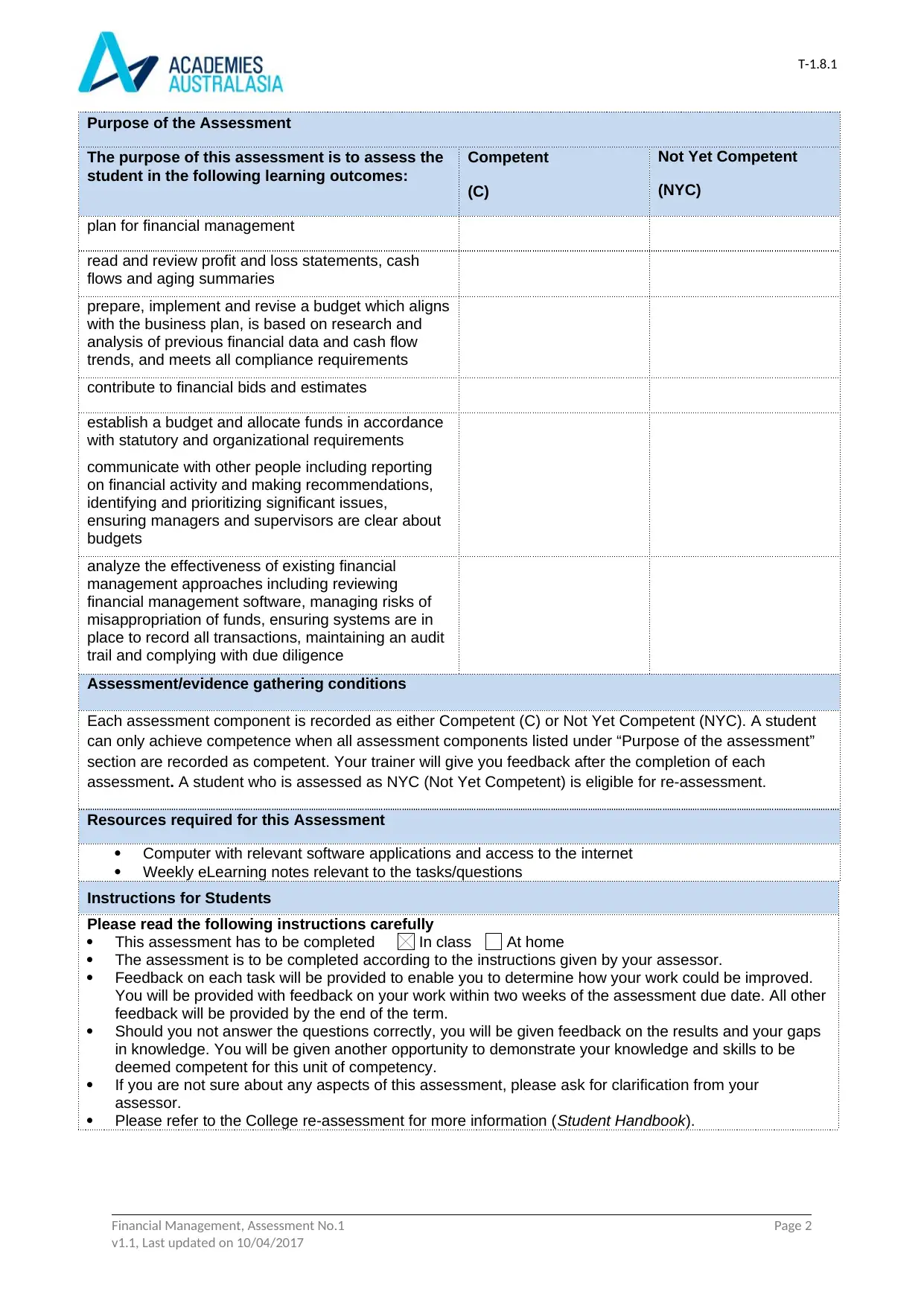
T-1.8.1
Purpose of the Assessment
The purpose of this assessment is to assess the
student in the following learning outcomes:
Competent
(C)
Not Yet Competent
(NYC)
plan for financial management
read and review profit and loss statements, cash
flows and aging summaries
prepare, implement and revise a budget which aligns
with the business plan, is based on research and
analysis of previous financial data and cash flow
trends, and meets all compliance requirements
contribute to financial bids and estimates
establish a budget and allocate funds in accordance
with statutory and organizational requirements
communicate with other people including reporting
on financial activity and making recommendations,
identifying and prioritizing significant issues,
ensuring managers and supervisors are clear about
budgets
analyze the effectiveness of existing financial
management approaches including reviewing
financial management software, managing risks of
misappropriation of funds, ensuring systems are in
place to record all transactions, maintaining an audit
trail and complying with due diligence
Assessment/evidence gathering conditions
Each assessment component is recorded as either Competent (C) or Not Yet Competent (NYC). A student
can only achieve competence when all assessment components listed under “Purpose of the assessment”
section are recorded as competent. Your trainer will give you feedback after the completion of each
assessment. A student who is assessed as NYC (Not Yet Competent) is eligible for re-assessment.
Resources required for this Assessment
Computer with relevant software applications and access to the internet
Weekly eLearning notes relevant to the tasks/questions
Instructions for Students
Please read the following instructions carefully
This assessment has to be completed In class At home
The assessment is to be completed according to the instructions given by your assessor.
Feedback on each task will be provided to enable you to determine how your work could be improved.
You will be provided with feedback on your work within two weeks of the assessment due date. All other
feedback will be provided by the end of the term.
Should you not answer the questions correctly, you will be given feedback on the results and your gaps
in knowledge. You will be given another opportunity to demonstrate your knowledge and skills to be
deemed competent for this unit of competency.
If you are not sure about any aspects of this assessment, please ask for clarification from your
assessor.
Please refer to the College re-assessment for more information (Student Handbook).
Financial Management, Assessment No.1 Page 2
v1.1, Last updated on 10/04/2017
Purpose of the Assessment
The purpose of this assessment is to assess the
student in the following learning outcomes:
Competent
(C)
Not Yet Competent
(NYC)
plan for financial management
read and review profit and loss statements, cash
flows and aging summaries
prepare, implement and revise a budget which aligns
with the business plan, is based on research and
analysis of previous financial data and cash flow
trends, and meets all compliance requirements
contribute to financial bids and estimates
establish a budget and allocate funds in accordance
with statutory and organizational requirements
communicate with other people including reporting
on financial activity and making recommendations,
identifying and prioritizing significant issues,
ensuring managers and supervisors are clear about
budgets
analyze the effectiveness of existing financial
management approaches including reviewing
financial management software, managing risks of
misappropriation of funds, ensuring systems are in
place to record all transactions, maintaining an audit
trail and complying with due diligence
Assessment/evidence gathering conditions
Each assessment component is recorded as either Competent (C) or Not Yet Competent (NYC). A student
can only achieve competence when all assessment components listed under “Purpose of the assessment”
section are recorded as competent. Your trainer will give you feedback after the completion of each
assessment. A student who is assessed as NYC (Not Yet Competent) is eligible for re-assessment.
Resources required for this Assessment
Computer with relevant software applications and access to the internet
Weekly eLearning notes relevant to the tasks/questions
Instructions for Students
Please read the following instructions carefully
This assessment has to be completed In class At home
The assessment is to be completed according to the instructions given by your assessor.
Feedback on each task will be provided to enable you to determine how your work could be improved.
You will be provided with feedback on your work within two weeks of the assessment due date. All other
feedback will be provided by the end of the term.
Should you not answer the questions correctly, you will be given feedback on the results and your gaps
in knowledge. You will be given another opportunity to demonstrate your knowledge and skills to be
deemed competent for this unit of competency.
If you are not sure about any aspects of this assessment, please ask for clarification from your
assessor.
Please refer to the College re-assessment for more information (Student Handbook).
Financial Management, Assessment No.1 Page 2
v1.1, Last updated on 10/04/2017
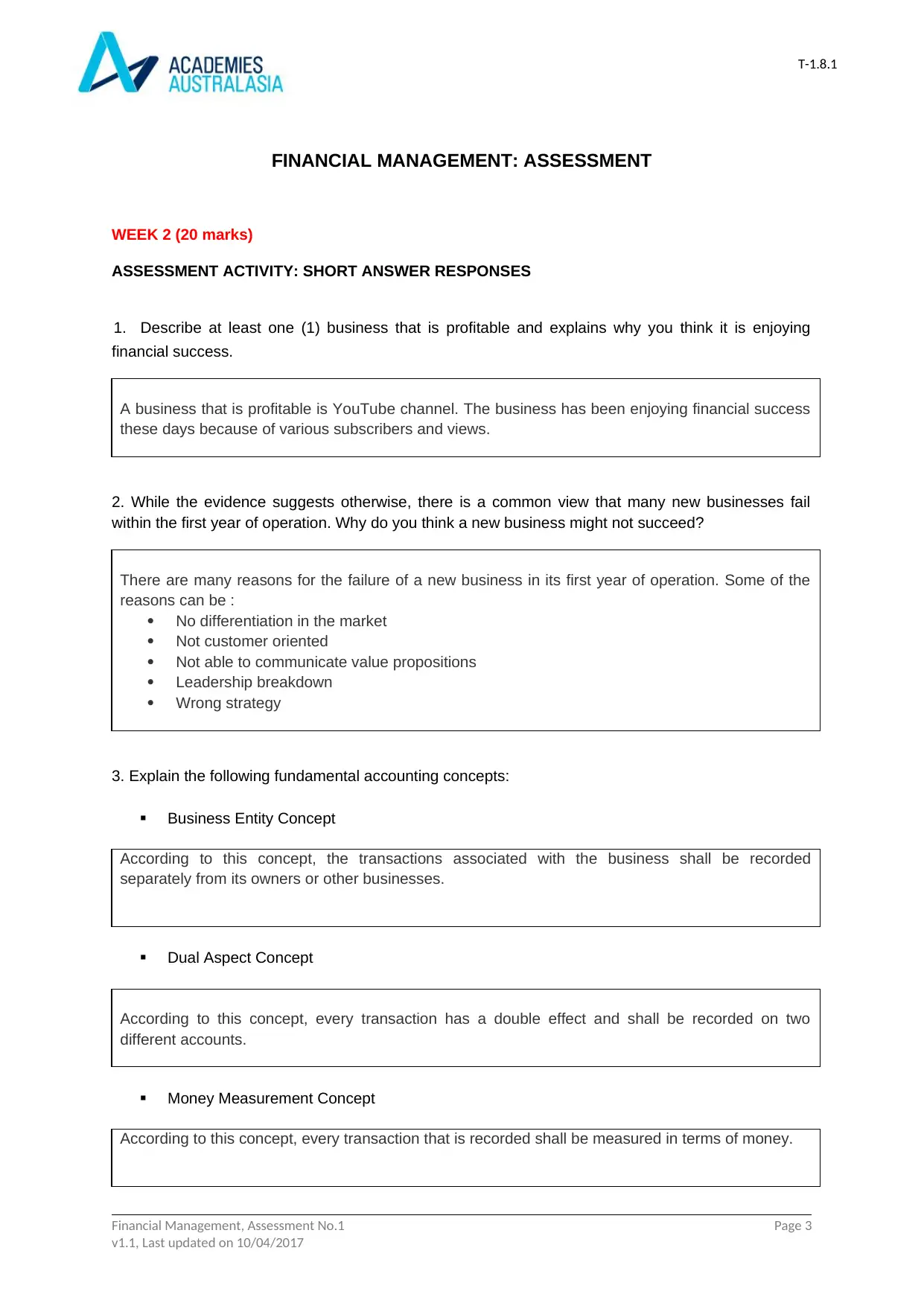
T-1.8.1
FINANCIAL MANAGEMENT: ASSESSMENT
WEEK 2 (20 marks)
ASSESSMENT ACTIVITY: SHORT ANSWER RESPONSES
1. Describe at least one (1) business that is profitable and explains why you think it is enjoying
financial success.
A business that is profitable is YouTube channel. The business has been enjoying financial success
these days because of various subscribers and views.
2. While the evidence suggests otherwise, there is a common view that many new businesses fail
within the first year of operation. Why do you think a new business might not succeed?
There are many reasons for the failure of a new business in its first year of operation. Some of the
reasons can be :
No differentiation in the market
Not customer oriented
Not able to communicate value propositions
Leadership breakdown
Wrong strategy
3. Explain the following fundamental accounting concepts:
Business Entity Concept
According to this concept, the transactions associated with the business shall be recorded
separately from its owners or other businesses.
Dual Aspect Concept
According to this concept, every transaction has a double effect and shall be recorded on two
different accounts.
Money Measurement Concept
According to this concept, every transaction that is recorded shall be measured in terms of money.
Financial Management, Assessment No.1 Page 3
v1.1, Last updated on 10/04/2017
FINANCIAL MANAGEMENT: ASSESSMENT
WEEK 2 (20 marks)
ASSESSMENT ACTIVITY: SHORT ANSWER RESPONSES
1. Describe at least one (1) business that is profitable and explains why you think it is enjoying
financial success.
A business that is profitable is YouTube channel. The business has been enjoying financial success
these days because of various subscribers and views.
2. While the evidence suggests otherwise, there is a common view that many new businesses fail
within the first year of operation. Why do you think a new business might not succeed?
There are many reasons for the failure of a new business in its first year of operation. Some of the
reasons can be :
No differentiation in the market
Not customer oriented
Not able to communicate value propositions
Leadership breakdown
Wrong strategy
3. Explain the following fundamental accounting concepts:
Business Entity Concept
According to this concept, the transactions associated with the business shall be recorded
separately from its owners or other businesses.
Dual Aspect Concept
According to this concept, every transaction has a double effect and shall be recorded on two
different accounts.
Money Measurement Concept
According to this concept, every transaction that is recorded shall be measured in terms of money.
Financial Management, Assessment No.1 Page 3
v1.1, Last updated on 10/04/2017
⊘ This is a preview!⊘
Do you want full access?
Subscribe today to unlock all pages.

Trusted by 1+ million students worldwide
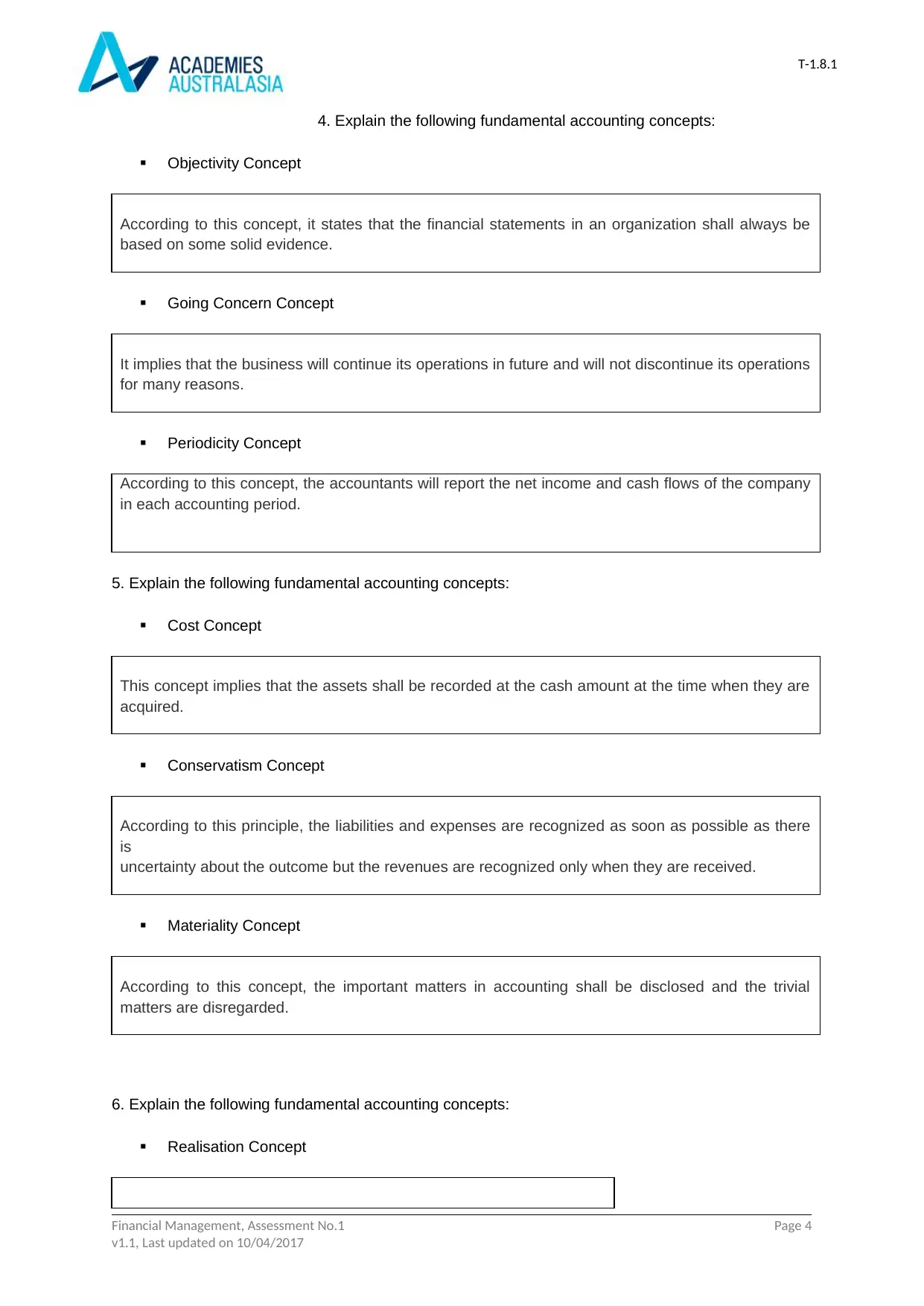
T-1.8.1
4. Explain the following fundamental accounting concepts:
Objectivity Concept
According to this concept, it states that the financial statements in an organization shall always be
based on some solid evidence.
Going Concern Concept
It implies that the business will continue its operations in future and will not discontinue its operations
for many reasons.
Periodicity Concept
According to this concept, the accountants will report the net income and cash flows of the company
in each accounting period.
5. Explain the following fundamental accounting concepts:
Cost Concept
This concept implies that the assets shall be recorded at the cash amount at the time when they are
acquired.
Conservatism Concept
According to this principle, the liabilities and expenses are recognized as soon as possible as there
is
uncertainty about the outcome but the revenues are recognized only when they are received.
Materiality Concept
According to this concept, the important matters in accounting shall be disclosed and the trivial
matters are disregarded.
6. Explain the following fundamental accounting concepts:
Realisation Concept
Financial Management, Assessment No.1 Page 4
v1.1, Last updated on 10/04/2017
4. Explain the following fundamental accounting concepts:
Objectivity Concept
According to this concept, it states that the financial statements in an organization shall always be
based on some solid evidence.
Going Concern Concept
It implies that the business will continue its operations in future and will not discontinue its operations
for many reasons.
Periodicity Concept
According to this concept, the accountants will report the net income and cash flows of the company
in each accounting period.
5. Explain the following fundamental accounting concepts:
Cost Concept
This concept implies that the assets shall be recorded at the cash amount at the time when they are
acquired.
Conservatism Concept
According to this principle, the liabilities and expenses are recognized as soon as possible as there
is
uncertainty about the outcome but the revenues are recognized only when they are received.
Materiality Concept
According to this concept, the important matters in accounting shall be disclosed and the trivial
matters are disregarded.
6. Explain the following fundamental accounting concepts:
Realisation Concept
Financial Management, Assessment No.1 Page 4
v1.1, Last updated on 10/04/2017
Paraphrase This Document
Need a fresh take? Get an instant paraphrase of this document with our AI Paraphraser
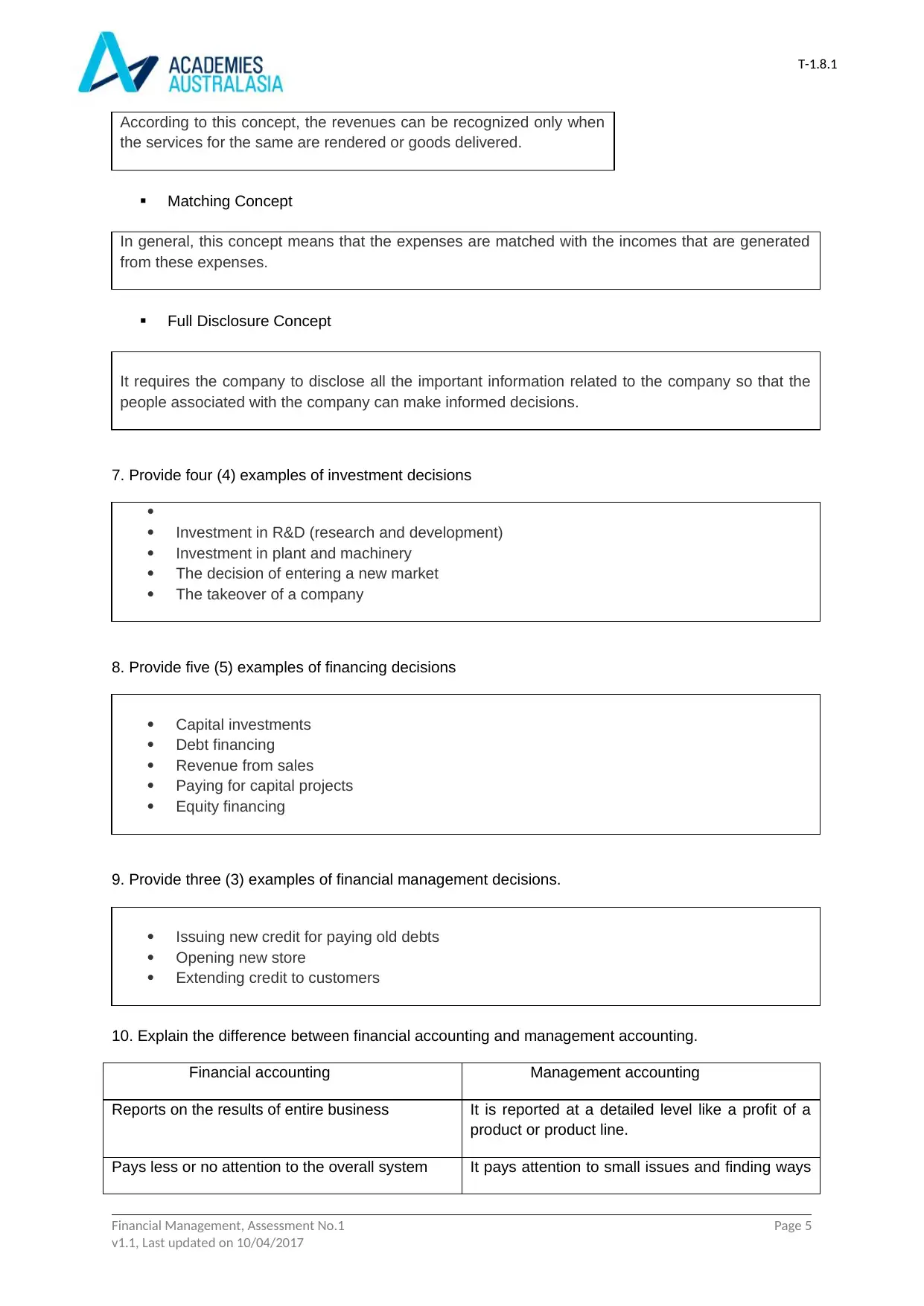
T-1.8.1
According to this concept, the revenues can be recognized only when
the services for the same are rendered or goods delivered.
Matching Concept
In general, this concept means that the expenses are matched with the incomes that are generated
from these expenses.
Full Disclosure Concept
It requires the company to disclose all the important information related to the company so that the
people associated with the company can make informed decisions.
7. Provide four (4) examples of investment decisions
Investment in R&D (research and development)
Investment in plant and machinery
The decision of entering a new market
The takeover of a company
8. Provide five (5) examples of financing decisions
Capital investments
Debt financing
Revenue from sales
Paying for capital projects
Equity financing
9. Provide three (3) examples of financial management decisions.
Issuing new credit for paying old debts
Opening new store
Extending credit to customers
10. Explain the difference between financial accounting and management accounting.
Financial accounting Management accounting
Reports on the results of entire business It is reported at a detailed level like a profit of a
product or product line.
Pays less or no attention to the overall system It pays attention to small issues and finding ways
Financial Management, Assessment No.1 Page 5
v1.1, Last updated on 10/04/2017
According to this concept, the revenues can be recognized only when
the services for the same are rendered or goods delivered.
Matching Concept
In general, this concept means that the expenses are matched with the incomes that are generated
from these expenses.
Full Disclosure Concept
It requires the company to disclose all the important information related to the company so that the
people associated with the company can make informed decisions.
7. Provide four (4) examples of investment decisions
Investment in R&D (research and development)
Investment in plant and machinery
The decision of entering a new market
The takeover of a company
8. Provide five (5) examples of financing decisions
Capital investments
Debt financing
Revenue from sales
Paying for capital projects
Equity financing
9. Provide three (3) examples of financial management decisions.
Issuing new credit for paying old debts
Opening new store
Extending credit to customers
10. Explain the difference between financial accounting and management accounting.
Financial accounting Management accounting
Reports on the results of entire business It is reported at a detailed level like a profit of a
product or product line.
Pays less or no attention to the overall system It pays attention to small issues and finding ways
Financial Management, Assessment No.1 Page 5
v1.1, Last updated on 10/04/2017
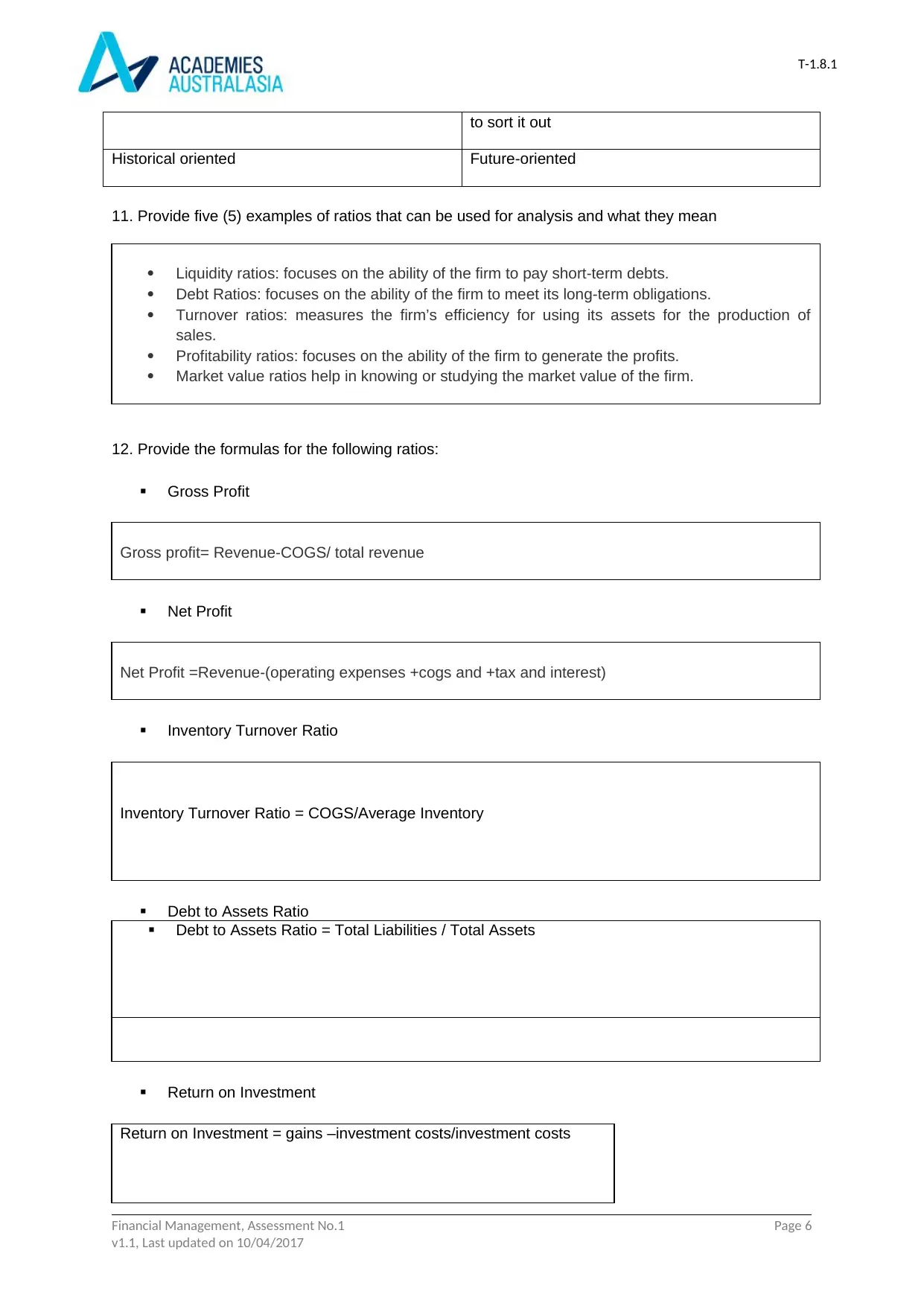
T-1.8.1
to sort it out
Historical oriented Future-oriented
11. Provide five (5) examples of ratios that can be used for analysis and what they mean
Liquidity ratios: focuses on the ability of the firm to pay short-term debts.
Debt Ratios: focuses on the ability of the firm to meet its long-term obligations.
Turnover ratios: measures the firm’s efficiency for using its assets for the production of
sales.
Profitability ratios: focuses on the ability of the firm to generate the profits.
Market value ratios help in knowing or studying the market value of the firm.
12. Provide the formulas for the following ratios:
Gross Profit
Gross profit= Revenue-COGS/ total revenue
Net Profit
Net Profit =Revenue-(operating expenses +cogs and +tax and interest)
Inventory Turnover Ratio
Inventory Turnover Ratio = COGS/Average Inventory
Debt to Assets Ratio
Debt to Assets Ratio = Total Liabilities / Total Assets
Return on Investment
Return on Investment = gains –investment costs/investment costs
Financial Management, Assessment No.1 Page 6
v1.1, Last updated on 10/04/2017
to sort it out
Historical oriented Future-oriented
11. Provide five (5) examples of ratios that can be used for analysis and what they mean
Liquidity ratios: focuses on the ability of the firm to pay short-term debts.
Debt Ratios: focuses on the ability of the firm to meet its long-term obligations.
Turnover ratios: measures the firm’s efficiency for using its assets for the production of
sales.
Profitability ratios: focuses on the ability of the firm to generate the profits.
Market value ratios help in knowing or studying the market value of the firm.
12. Provide the formulas for the following ratios:
Gross Profit
Gross profit= Revenue-COGS/ total revenue
Net Profit
Net Profit =Revenue-(operating expenses +cogs and +tax and interest)
Inventory Turnover Ratio
Inventory Turnover Ratio = COGS/Average Inventory
Debt to Assets Ratio
Debt to Assets Ratio = Total Liabilities / Total Assets
Return on Investment
Return on Investment = gains –investment costs/investment costs
Financial Management, Assessment No.1 Page 6
v1.1, Last updated on 10/04/2017
⊘ This is a preview!⊘
Do you want full access?
Subscribe today to unlock all pages.

Trusted by 1+ million students worldwide
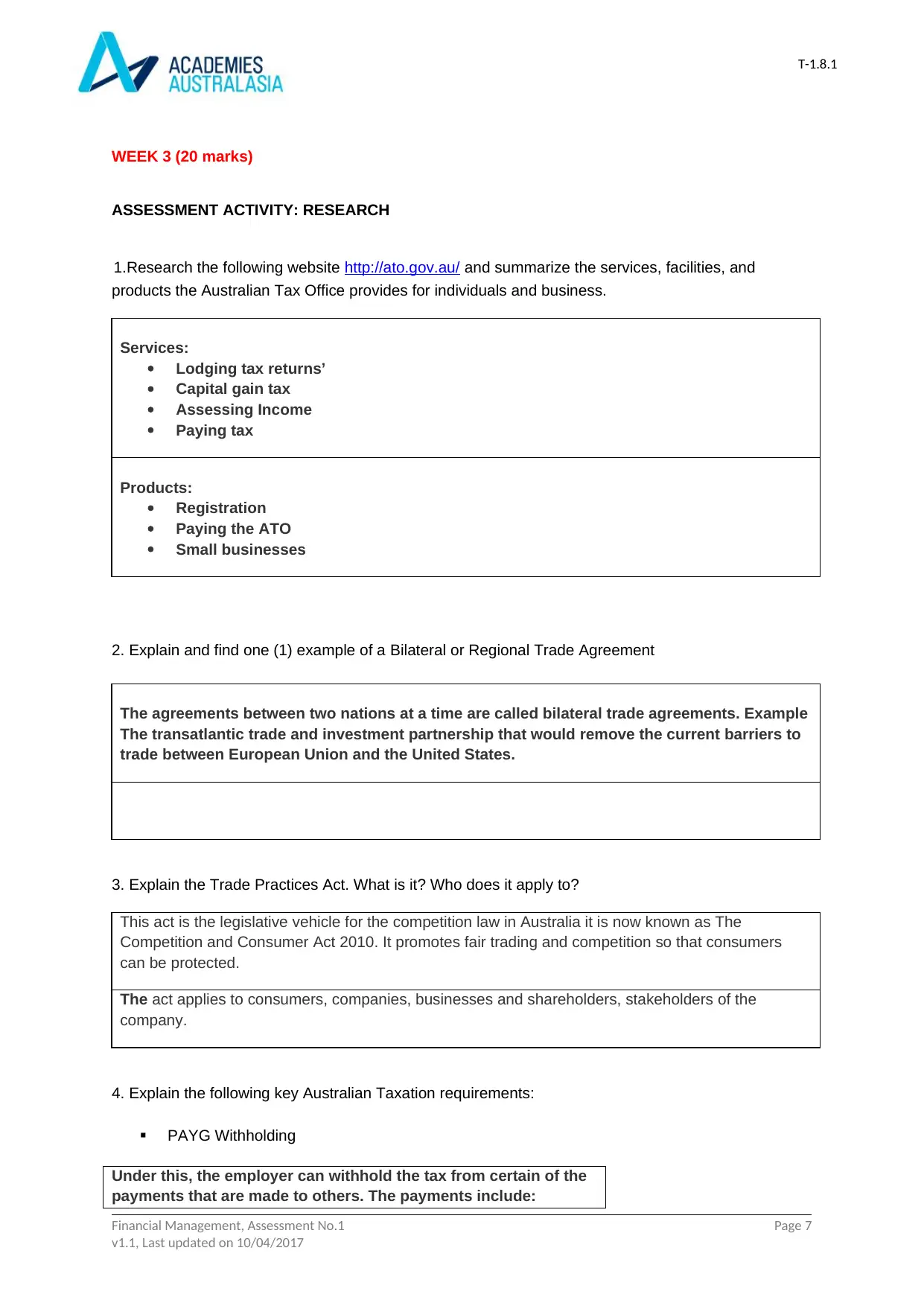
T-1.8.1
WEEK 3 (20 marks)
ASSESSMENT ACTIVITY: RESEARCH
1.Research the following website http://ato.gov.au/ and summarize the services, facilities, and
products the Australian Tax Office provides for individuals and business.
Services:
Lodging tax returns’
Capital gain tax
Assessing Income
Paying tax
Products:
Registration
Paying the ATO
Small businesses
2. Explain and find one (1) example of a Bilateral or Regional Trade Agreement
The agreements between two nations at a time are called bilateral trade agreements. Example
The transatlantic trade and investment partnership that would remove the current barriers to
trade between European Union and the United States.
3. Explain the Trade Practices Act. What is it? Who does it apply to?
This act is the legislative vehicle for the competition law in Australia it is now known as The
Competition and Consumer Act 2010. It promotes fair trading and competition so that consumers
can be protected.
The act applies to consumers, companies, businesses and shareholders, stakeholders of the
company.
4. Explain the following key Australian Taxation requirements:
PAYG Withholding
Under this, the employer can withhold the tax from certain of the
payments that are made to others. The payments include:
Financial Management, Assessment No.1 Page 7
v1.1, Last updated on 10/04/2017
WEEK 3 (20 marks)
ASSESSMENT ACTIVITY: RESEARCH
1.Research the following website http://ato.gov.au/ and summarize the services, facilities, and
products the Australian Tax Office provides for individuals and business.
Services:
Lodging tax returns’
Capital gain tax
Assessing Income
Paying tax
Products:
Registration
Paying the ATO
Small businesses
2. Explain and find one (1) example of a Bilateral or Regional Trade Agreement
The agreements between two nations at a time are called bilateral trade agreements. Example
The transatlantic trade and investment partnership that would remove the current barriers to
trade between European Union and the United States.
3. Explain the Trade Practices Act. What is it? Who does it apply to?
This act is the legislative vehicle for the competition law in Australia it is now known as The
Competition and Consumer Act 2010. It promotes fair trading and competition so that consumers
can be protected.
The act applies to consumers, companies, businesses and shareholders, stakeholders of the
company.
4. Explain the following key Australian Taxation requirements:
PAYG Withholding
Under this, the employer can withhold the tax from certain of the
payments that are made to others. The payments include:
Financial Management, Assessment No.1 Page 7
v1.1, Last updated on 10/04/2017
Paraphrase This Document
Need a fresh take? Get an instant paraphrase of this document with our AI Paraphraser
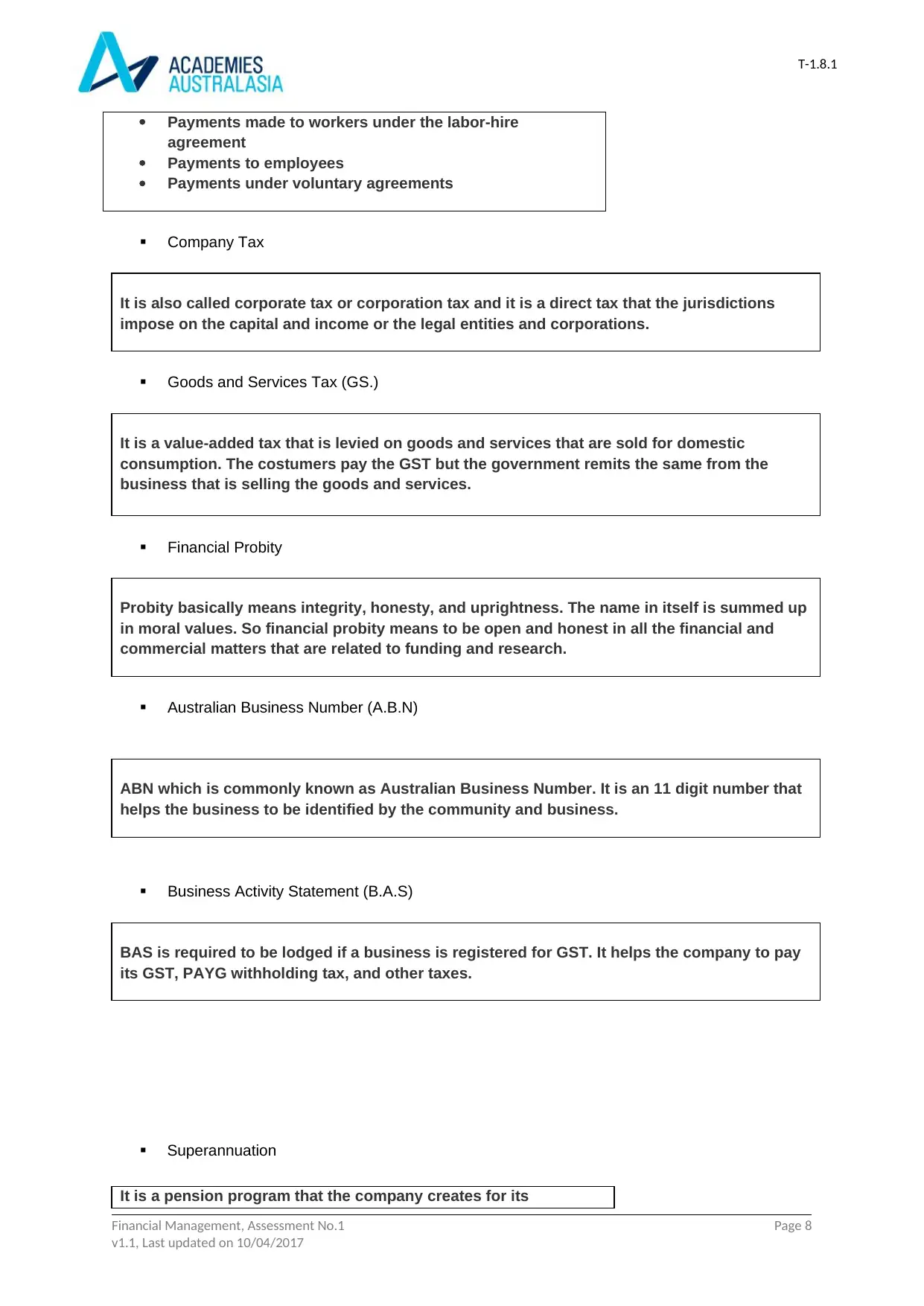
T-1.8.1
Payments made to workers under the labor-hire
agreement
Payments to employees
Payments under voluntary agreements
Company Tax
It is also called corporate tax or corporation tax and it is a direct tax that the jurisdictions
impose on the capital and income or the legal entities and corporations.
Goods and Services Tax (GS.)
It is a value-added tax that is levied on goods and services that are sold for domestic
consumption. The costumers pay the GST but the government remits the same from the
business that is selling the goods and services.
Financial Probity
Probity basically means integrity, honesty, and uprightness. The name in itself is summed up
in moral values. So financial probity means to be open and honest in all the financial and
commercial matters that are related to funding and research.
Australian Business Number (A.B.N)
ABN which is commonly known as Australian Business Number. It is an 11 digit number that
helps the business to be identified by the community and business.
Business Activity Statement (B.A.S)
BAS is required to be lodged if a business is registered for GST. It helps the company to pay
its GST, PAYG withholding tax, and other taxes.
Superannuation
It is a pension program that the company creates for its
Financial Management, Assessment No.1 Page 8
v1.1, Last updated on 10/04/2017
Payments made to workers under the labor-hire
agreement
Payments to employees
Payments under voluntary agreements
Company Tax
It is also called corporate tax or corporation tax and it is a direct tax that the jurisdictions
impose on the capital and income or the legal entities and corporations.
Goods and Services Tax (GS.)
It is a value-added tax that is levied on goods and services that are sold for domestic
consumption. The costumers pay the GST but the government remits the same from the
business that is selling the goods and services.
Financial Probity
Probity basically means integrity, honesty, and uprightness. The name in itself is summed up
in moral values. So financial probity means to be open and honest in all the financial and
commercial matters that are related to funding and research.
Australian Business Number (A.B.N)
ABN which is commonly known as Australian Business Number. It is an 11 digit number that
helps the business to be identified by the community and business.
Business Activity Statement (B.A.S)
BAS is required to be lodged if a business is registered for GST. It helps the company to pay
its GST, PAYG withholding tax, and other taxes.
Superannuation
It is a pension program that the company creates for its
Financial Management, Assessment No.1 Page 8
v1.1, Last updated on 10/04/2017
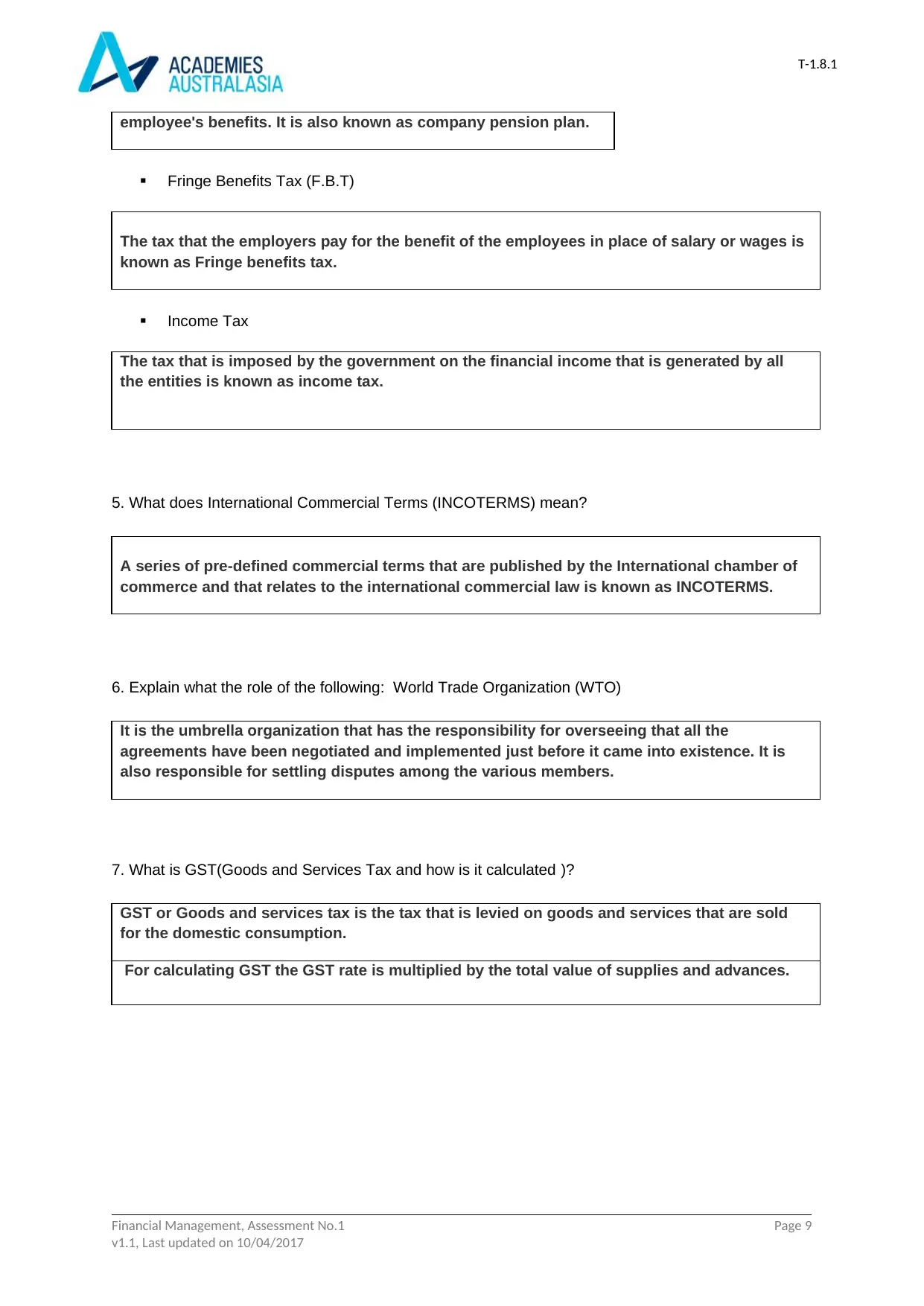
T-1.8.1
employee's benefits. It is also known as company pension plan.
Fringe Benefits Tax (F.B.T)
The tax that the employers pay for the benefit of the employees in place of salary or wages is
known as Fringe benefits tax.
Income Tax
The tax that is imposed by the government on the financial income that is generated by all
the entities is known as income tax.
5. What does International Commercial Terms (INCOTERMS) mean?
A series of pre-defined commercial terms that are published by the International chamber of
commerce and that relates to the international commercial law is known as INCOTERMS.
6. Explain what the role of the following: World Trade Organization (WTO)
It is the umbrella organization that has the responsibility for overseeing that all the
agreements have been negotiated and implemented just before it came into existence. It is
also responsible for settling disputes among the various members.
7. What is GST(Goods and Services Tax and how is it calculated )?
GST or Goods and services tax is the tax that is levied on goods and services that are sold
for the domestic consumption.
For calculating GST the GST rate is multiplied by the total value of supplies and advances.
Financial Management, Assessment No.1 Page 9
v1.1, Last updated on 10/04/2017
employee's benefits. It is also known as company pension plan.
Fringe Benefits Tax (F.B.T)
The tax that the employers pay for the benefit of the employees in place of salary or wages is
known as Fringe benefits tax.
Income Tax
The tax that is imposed by the government on the financial income that is generated by all
the entities is known as income tax.
5. What does International Commercial Terms (INCOTERMS) mean?
A series of pre-defined commercial terms that are published by the International chamber of
commerce and that relates to the international commercial law is known as INCOTERMS.
6. Explain what the role of the following: World Trade Organization (WTO)
It is the umbrella organization that has the responsibility for overseeing that all the
agreements have been negotiated and implemented just before it came into existence. It is
also responsible for settling disputes among the various members.
7. What is GST(Goods and Services Tax and how is it calculated )?
GST or Goods and services tax is the tax that is levied on goods and services that are sold
for the domestic consumption.
For calculating GST the GST rate is multiplied by the total value of supplies and advances.
Financial Management, Assessment No.1 Page 9
v1.1, Last updated on 10/04/2017
⊘ This is a preview!⊘
Do you want full access?
Subscribe today to unlock all pages.

Trusted by 1+ million students worldwide
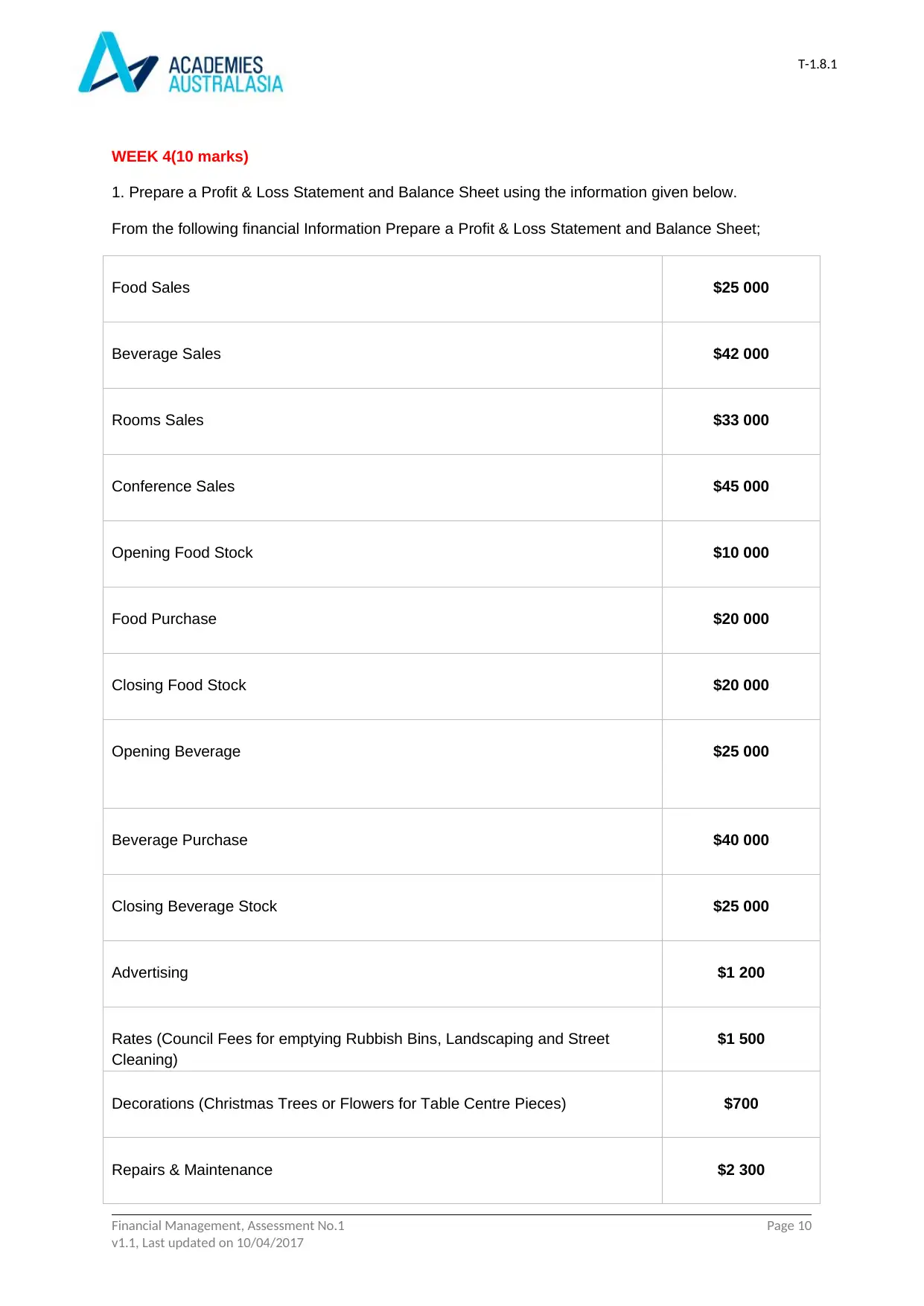
T-1.8.1
WEEK 4(10 marks)
1. Prepare a Profit & Loss Statement and Balance Sheet using the information given below.
From the following financial Information Prepare a Profit & Loss Statement and Balance Sheet;
Food Sales $25 000
Beverage Sales $42 000
Rooms Sales $33 000
Conference Sales $45 000
Opening Food Stock $10 000
Food Purchase $20 000
Closing Food Stock $20 000
Opening Beverage $25 000
Beverage Purchase $40 000
Closing Beverage Stock $25 000
Advertising $1 200
Rates (Council Fees for emptying Rubbish Bins, Landscaping and Street
Cleaning)
$1 500
Decorations (Christmas Trees or Flowers for Table Centre Pieces) $700
Repairs & Maintenance $2 300
Financial Management, Assessment No.1 Page 10
v1.1, Last updated on 10/04/2017
WEEK 4(10 marks)
1. Prepare a Profit & Loss Statement and Balance Sheet using the information given below.
From the following financial Information Prepare a Profit & Loss Statement and Balance Sheet;
Food Sales $25 000
Beverage Sales $42 000
Rooms Sales $33 000
Conference Sales $45 000
Opening Food Stock $10 000
Food Purchase $20 000
Closing Food Stock $20 000
Opening Beverage $25 000
Beverage Purchase $40 000
Closing Beverage Stock $25 000
Advertising $1 200
Rates (Council Fees for emptying Rubbish Bins, Landscaping and Street
Cleaning)
$1 500
Decorations (Christmas Trees or Flowers for Table Centre Pieces) $700
Repairs & Maintenance $2 300
Financial Management, Assessment No.1 Page 10
v1.1, Last updated on 10/04/2017
Paraphrase This Document
Need a fresh take? Get an instant paraphrase of this document with our AI Paraphraser
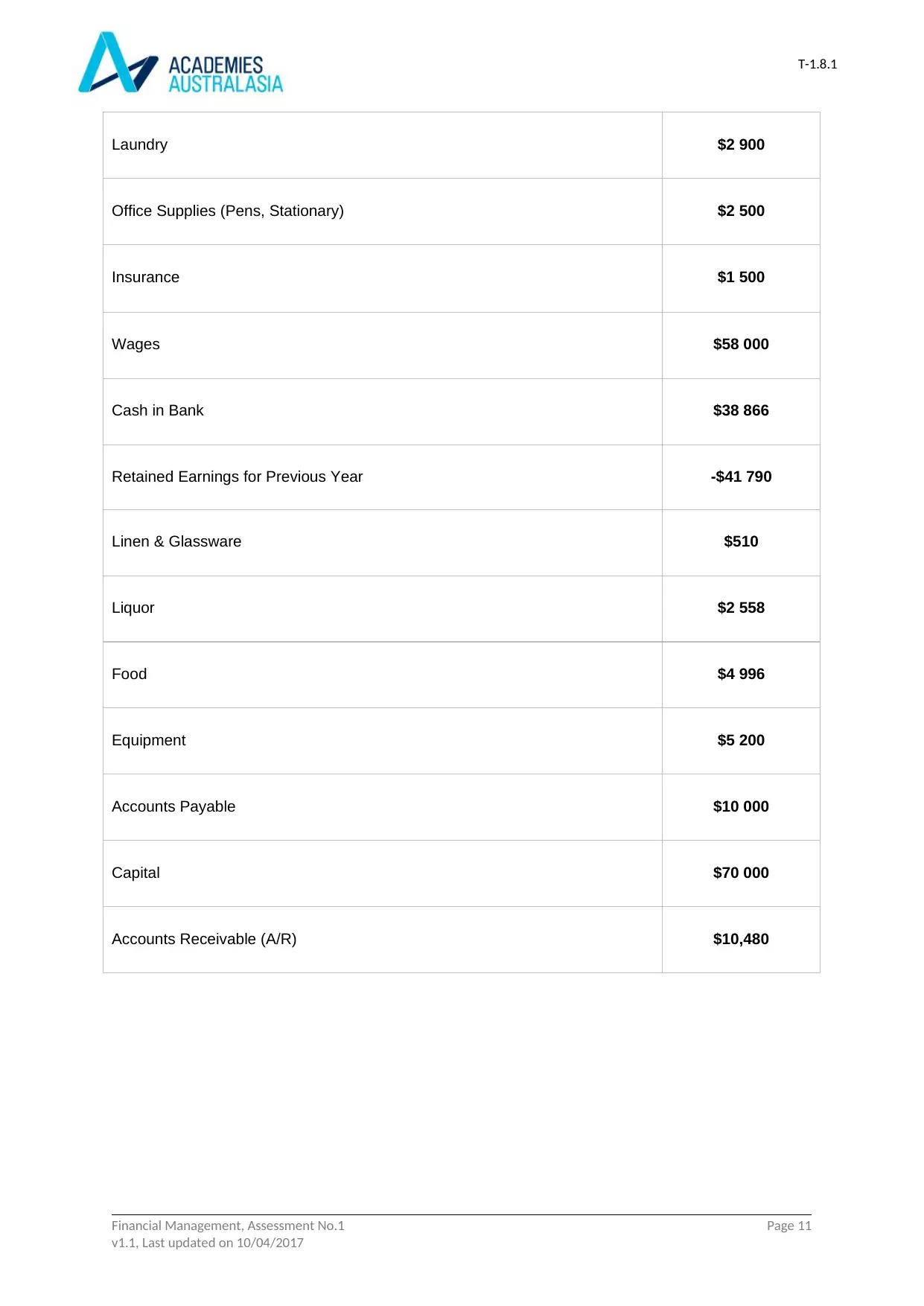
T-1.8.1
Laundry $2 900
Office Supplies (Pens, Stationary) $2 500
Insurance $1 500
Wages $58 000
Cash in Bank $38 866
Retained Earnings for Previous Year -$41 790
Linen & Glassware $510
Liquor $2 558
Food $4 996
Equipment $5 200
Accounts Payable $10 000
Capital $70 000
Accounts Receivable (A/R) $10,480
Financial Management, Assessment No.1 Page 11
v1.1, Last updated on 10/04/2017
Laundry $2 900
Office Supplies (Pens, Stationary) $2 500
Insurance $1 500
Wages $58 000
Cash in Bank $38 866
Retained Earnings for Previous Year -$41 790
Linen & Glassware $510
Liquor $2 558
Food $4 996
Equipment $5 200
Accounts Payable $10 000
Capital $70 000
Accounts Receivable (A/R) $10,480
Financial Management, Assessment No.1 Page 11
v1.1, Last updated on 10/04/2017
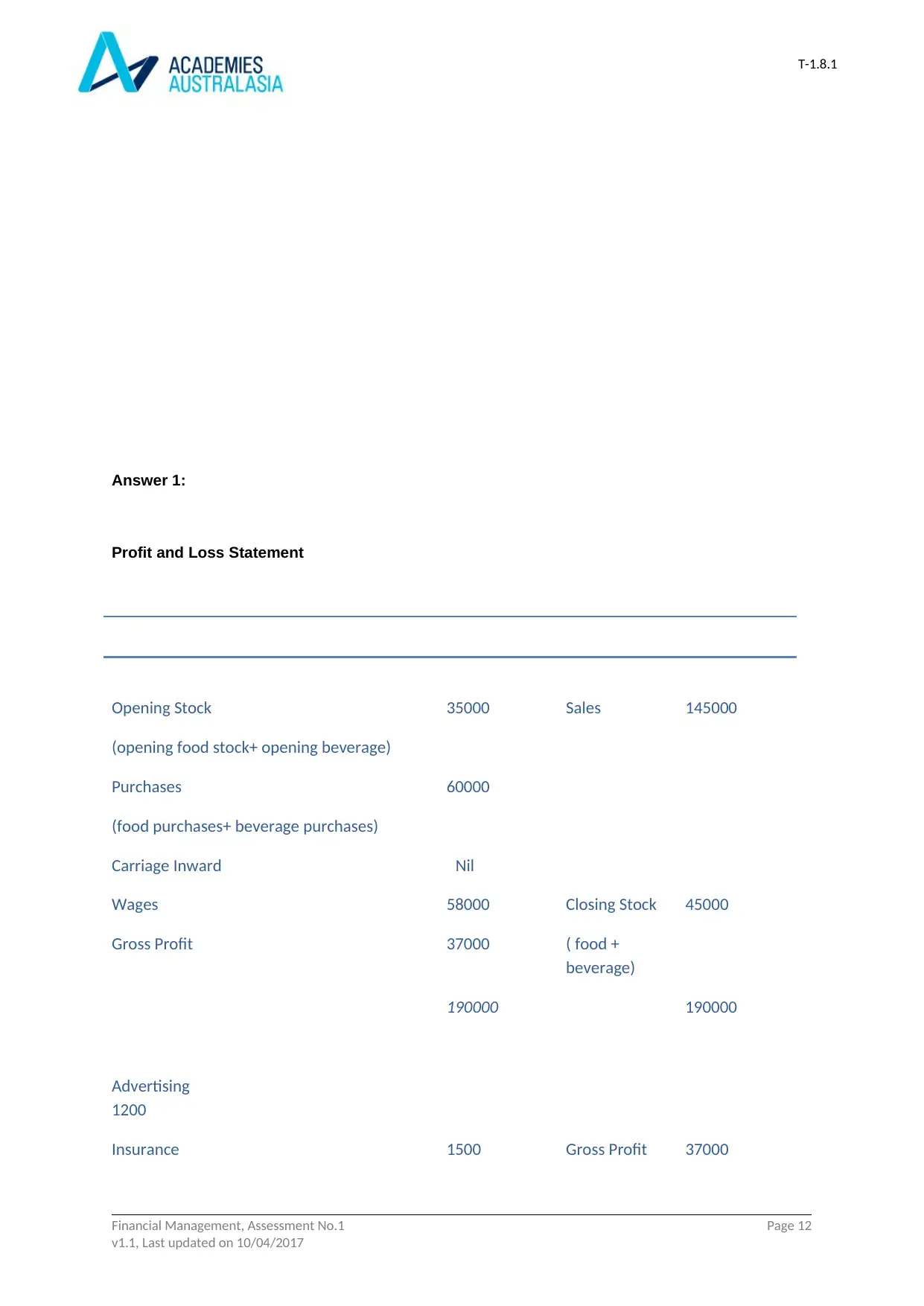
T-1.8.1
Answer 1:
Profit and Loss Statement
Opening Stock
(opening food stock+ opening beverage)
35000 Sales 145000
Purchases
(food purchases+ beverage purchases)
60000
Carriage Inward Nil
Wages 58000 Closing Stock 45000
Gross Profit 37000 ( food +
beverage)
190000 190000
Advertising
1200
Insurance 1500 Gross Profit 37000
Financial Management, Assessment No.1 Page 12
v1.1, Last updated on 10/04/2017
Answer 1:
Profit and Loss Statement
Opening Stock
(opening food stock+ opening beverage)
35000 Sales 145000
Purchases
(food purchases+ beverage purchases)
60000
Carriage Inward Nil
Wages 58000 Closing Stock 45000
Gross Profit 37000 ( food +
beverage)
190000 190000
Advertising
1200
Insurance 1500 Gross Profit 37000
Financial Management, Assessment No.1 Page 12
v1.1, Last updated on 10/04/2017
⊘ This is a preview!⊘
Do you want full access?
Subscribe today to unlock all pages.

Trusted by 1+ million students worldwide
1 out of 22
Related Documents
Your All-in-One AI-Powered Toolkit for Academic Success.
+13062052269
info@desklib.com
Available 24*7 on WhatsApp / Email
![[object Object]](/_next/static/media/star-bottom.7253800d.svg)
Unlock your academic potential
Copyright © 2020–2025 A2Z Services. All Rights Reserved. Developed and managed by ZUCOL.





